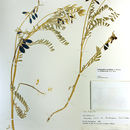Comprehensive Description
provided by North American Flora
Hesperonix accidens (S. Wats.) Rydberg
Astragalus accidens S. Wats. Proc. Am. Acad. 22: 471. 1887.
A perennial; stems 3-5 dm. high, striate, sparingly villous; leaves ascending, 8-10 cm. long, the rachis sparingly villous; stipules lanceolate, free, 4-5 mm. long; leaflets 21-33, oblong or elliptic, 8-20 mm. long, cuneate at the base, truncate or retuse at the apex, glabrous above, pilose beneath ; peduncles about 1 dm. long; racemes 2-5 cm. long; bracts subulate, 3 mm. long; pedicels 1 mm. long; flowers reflexed; calyx black-hairy, the tube 4 mm. long, 3 mm. broad, the teeth lance-subulate, 1.5 mm. long; corolla white or cream-colored, 1 5—1 S mm. long; banner narrowly ovate, moderately arched at the middle; wings oblong-falcate, obtuse, the blade nearly twice as long as the claw, with a large reflexed auricle; keel-petals about 10 mm. long, the blade broadly lunate, with a large auricle; pod strigose, stipitate, coriaceous, the stipe about 6 mm. long, straight, the body oval-obovoid, abruptly contracted at each end, reticulate, 15 mm. long, 6 mm. wide and thick, terete, the sutures somewhat prominent.
Type locality: Southern Oregon.
Distribution: Oregon.
- bibliographic citation
- Per Axel Rydberg. 1919. (ROSALES); FABACEAE; PSORALEAE. North American flora. vol 24(1). New York Botanical Garden, New York, NY
Physical Description
provided by USDA PLANTS text
Perennial, Herbs, Stems woody below, or from woody crown or caudex, Taproot present, Nodules present, Stems erect or ascending, Stems or branches arching, spreading or decumbent, Stems less than 1 m tall, Stems solid, Stems or young twigs glabrous or sparsely glabrate, Stems or young twigs sparsely to densel y hairy, Leaves alternate, Leaves petiolate, Stipules conspicuous, Stipules membranous or chartaceous, Stipules persistent, Stipules free, Leaves compound, Leaves odd pinnate, Leaf or leaflet margins entire, Leaflets opposite, Leaflets alternate or subopposite, Leaflets 10-many, Leaves hairy on one or both surfaces, Inflorescences racemes, Inflorescence axillary, Bracts very small, absent or caducous, Flowers zygomorphic, Calyx 5-lobed, Calyx hairy, Petals separate, Corolla papilionaceous, Petals clawed, Petals white, Banner petal narrow or oblanceolate, Wing petals narrow, oblanceolate to oblong, Wing tips obtuse or rounded, Keel tips obtuse or rounded, not beaked, Stamens 9-10, Stamens diadelphous, 9 united, 1 free, Filaments glabrous, Style terete, Style persistent in fruit, Fruit a legume, Fruit stipitate, Fruit humistrate, lying on the ground, Fruit tardily or weakly dehiscent, Fruit elongate, straight, Fruit oblong or ellipsoidal, Fruit rugose wrinkled or reticulate, F ruit fleshy, Fruit coriaceous or becoming woody, Fruit exserted from calyx, Fruit inflated or turgid, Fruit beaked, Fruit glabrous or glabrate, Fruit 11-many seeded, Seeds cordiform, mit-shaped, notched at one end, Seed surface smooth, Seeds olive, brown, or black.

